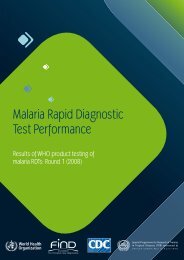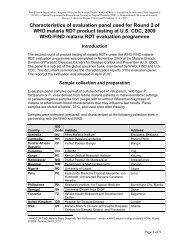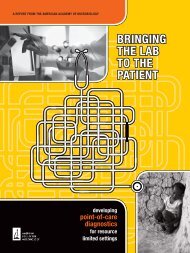MGIT TM Procedure Manual - Foundation for Innovative New ...
MGIT TM Procedure Manual - Foundation for Innovative New ...
MGIT TM Procedure Manual - Foundation for Innovative New ...
You also want an ePaper? Increase the reach of your titles
YUMPU automatically turns print PDFs into web optimized ePapers that Google loves.
Section III: Drug Susceptibility Testing<br />
A. Primary Drug Susceptibility Testing (SIRE)<br />
1. Introduction<br />
Antimicrobial susceptibility testing is critical in prescribing an effective drug regime <strong>for</strong> a<br />
tuberculosis patient, especially in areas where drug resistance incidence is high. It is also<br />
important in the follow-up of patients who are on antimicrobial therapy but are not<br />
responding to therapy. Drug susceptibility testing is an integral part of the WHO DOTS-Plus<br />
program.<br />
The BACTEC <strong>MGIT</strong> 960 susceptibility testing <strong>for</strong> Streptomycin (S), Isoniazid (I), Rifampin<br />
(R) and Ethambutol (E), called SIRE, is a rapid and qualitative procedure <strong>for</strong> establishing<br />
susceptibility of M. tuberculosis <strong>for</strong> the four drugs using critical test concentrations. In<br />
addition, higher test concentrations <strong>for</strong> S, I and E (high E not available in US) are also<br />
available in case of testing against higher concentrations is indicated.<br />
2. Principles of the test<br />
Isolated cultures from TB patients are subjected to growth in the presence of a known<br />
concentration of a test drug. A control is also included with no addition of the drug. If the<br />
patient’s isolate grows in the control but does not grow in presence of the drug, it is<br />
considered susceptible. On the other hand, if it grows in both the tubes, then it is considered<br />
to be resistant to that drug.<br />
There are several methods <strong>for</strong> susceptibility testing but the most common one is the<br />
proportion method. In the proportion method, resistance is established at the 1% level <strong>for</strong><br />
most of the drugs. This means that if 1% or more of the total test bacterial population is<br />
resistant to a drug it is considered as resistant <strong>for</strong> clinical purposes. Historically, proportion<br />
method has used Middlebrook agar solid medium. After 3 to 4 weeks of incubation, the<br />
percentage of colonies on the drug medium, as compared with the drug-free medium, is<br />
calculated to establish resistance.<br />
In 1980, a broth-based proportion method known as BACTEC 460TB radiometric<br />
susceptibility testing was introduced. In this method, a radiometric medium, BACTEC 12B,<br />
with a C 14 -labeled substrate is used. The bacterial inoculum in the control is a hundredfold<br />
less than the inoculum in the drug-containing medium. The 14 CO2 produced during growth<br />
and metabolism of mycobacteria in this medium is measured and designated as the Growth<br />
Index (GI). Once the GI in the control reaches 30, usually after 4-6 days incubation<br />
(maximum 12 days), comparison of GI values in the drug-containing and drug-free medium<br />
8, 9<br />
establishes the proportion of resistance.<br />
<strong>MGIT</strong> <strong>TM</strong> <strong>Procedure</strong> <strong>Manual</strong> 41


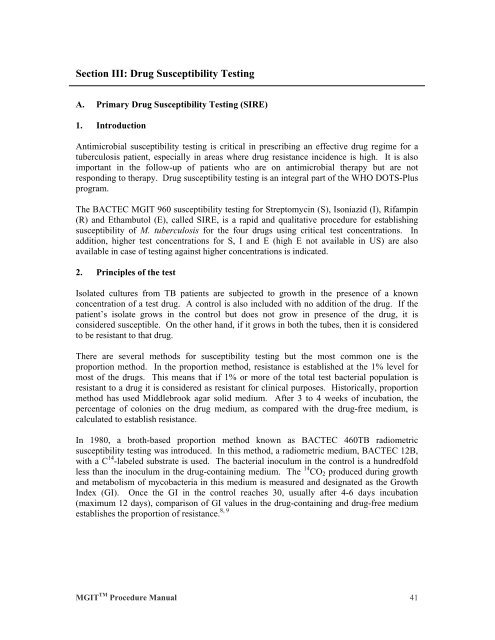

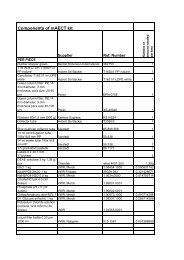
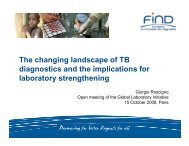
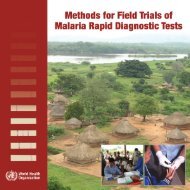
![Download in English [pdf 2Mb] - Foundation for Innovative New ...](https://img.yumpu.com/49580359/1/184x260/download-in-english-pdf-2mb-foundation-for-innovative-new-.jpg?quality=85)

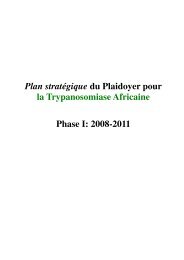
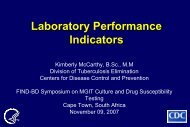
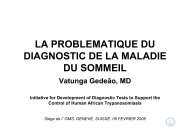
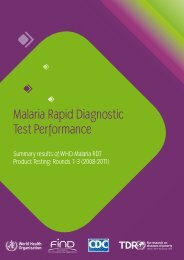
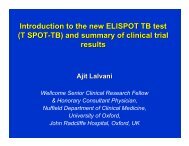
![New laboratory diagnostic tools for tuberculosis control [.pdf]](https://img.yumpu.com/43339906/1/190x135/new-laboratory-diagnostic-tools-for-tuberculosis-control-pdf.jpg?quality=85)
